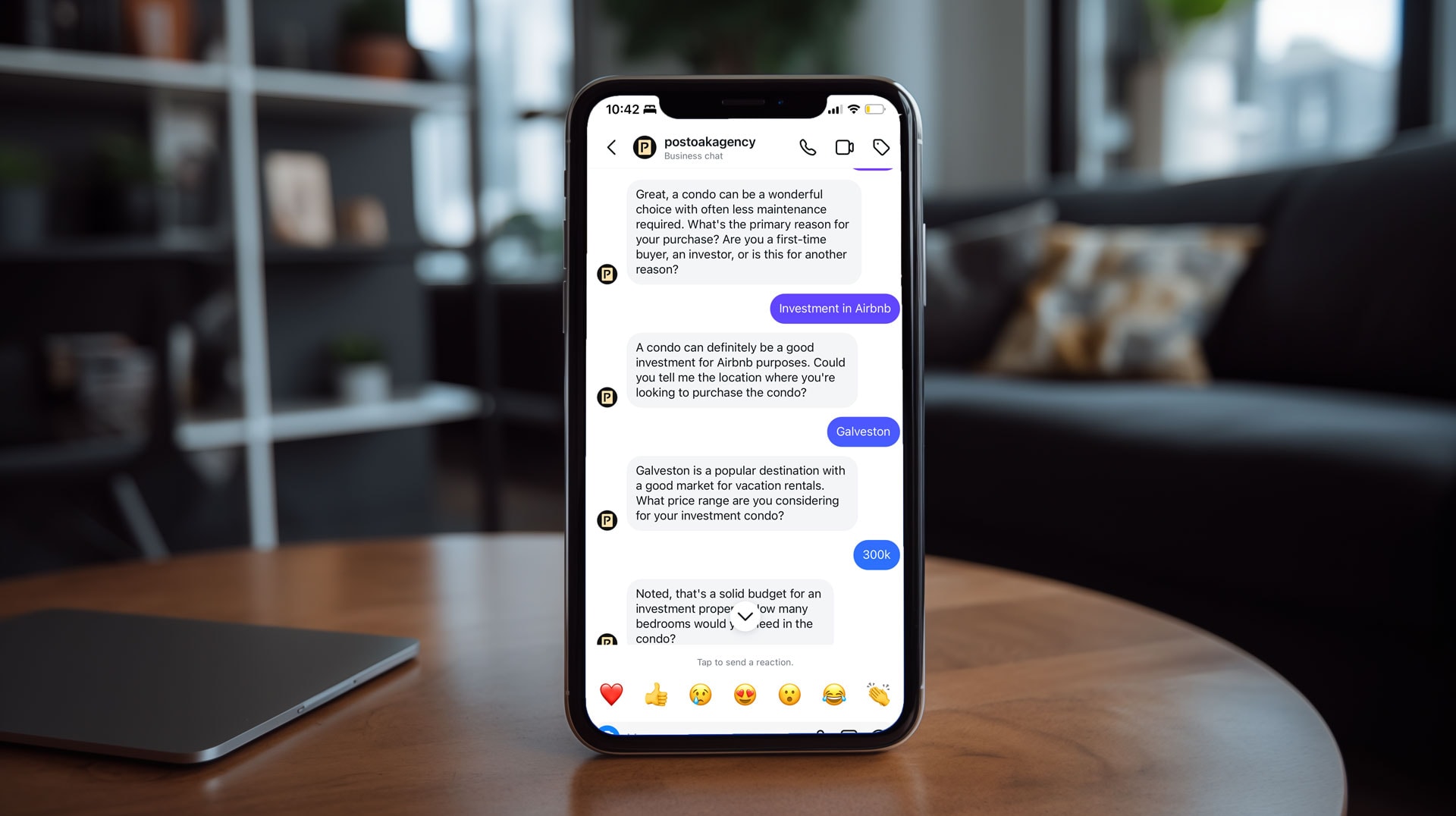How to Use a Chatbot for Real Estate Instagram Ads

13 min read
In today's digital world, technology has revolutionized the way businesses reach and engage with their target audience. One such technology that has gained immense popularity is chatbots. These intelligent virtual assistants can automate customer interactions, answer queries, and provide valuable information in real time. For real estate agents looking to boost their Instagram advertising efforts, integrating a chatbot can be a game-changer. In this article, we will explore how to effectively use a chatbot for real estate Instagram ads and leverage its potential to generate leads and increase conversions.
Need a chat solution for your real estate business? Take a look at our Real Estate Marketer AI Chatbot!
This built-for-you chatbot integtates seamelessly into your Facebook and Instagram ads so you don't speak to any leads until you know they're qualified, saving you hours of time and energy.
Understanding the Role of Chatbots in Real Estate
Before delving into the specifics, it's essential to grasp the basics of chatbots and their significance in the real estate industry. Chatbots are computer programs designed to simulate human conversation, enabling users to interact with them naturally. In the realm of real estate, chatbots serve as a valuable tool to improve customer engagement, automate lead generation, and provide personalized assistance throughout the sales process.
Chatbots have revolutionized the way real estate agents interact with potential buyers and sellers. These intelligent virtual assistants are capable of handling various tasks, such as answering frequently asked questions, scheduling property viewings, and even providing virtual tours. By automating these processes, agents can focus their time and energy on building relationships and closing deals.
The Basics of Chatbots
A chatbot operates based on predefined rules or artificial intelligence algorithms. Rule-based chatbots follow a predefined set of instructions and responses, while AI-powered chatbots can learn and adapt based on previous interactions. Rule-based chatbots are ideal for handling simple queries and providing basic information, while AI-powered chatbots excel in understanding complex user requests and delivering personalized responses.
Real estate agents can choose the type of chatbot that best suits their needs and resources. Rule-based chatbots are relatively easy to set up and require less maintenance, making them a cost-effective option for smaller agencies. On the other hand, AI-powered chatbots offer advanced features like natural language processing and sentiment analysis, allowing for more sophisticated conversations and personalized experiences.
Why Chatbots are Important in Real Estate
The real estate industry thrives on timely communication and personalized interactions. Chatbots offer the perfect solution by providing instant responses, 24/7 availability, and consistent messaging. Moreover, they can handle multiple conversations simultaneously, ensuring that no lead goes unattended. By incorporating chatbots into real estate Instagram ads, agents can create a seamless customer journey, capturing inquiries and nurturing leads without missing a beat.
Chatbots also play a crucial role in lead generation. They can engage website visitors, capture their contact information, and qualify leads based on their preferences and requirements. By automating this process, agents can identify and prioritize high-quality leads, saving time and resources.
Furthermore, chatbots can provide personalized assistance throughout the sales process. They can recommend properties based on user preferences, provide detailed information about listings, and even assist with mortgage calculations. By offering tailored recommendations and valuable insights, chatbots enhance the overall customer experience and increase the likelihood of successful transactions.
In conclusion, chatbots have become indispensable tools in the real estate industry. They streamline communication, automate lead generation, and provide personalized assistance to potential buyers and sellers. By leveraging the power of chatbots, real estate agents can enhance customer engagement, improve efficiency, and ultimately drive more sales.
Setting Up Your Real Estate Chatbot
Once you recognize the potential of chatbots in your real estate Instagram ad strategy, it's time to choose the right platform and customize your chatbot for optimal performance.
Chatbots have revolutionized the way businesses interact with their customers, and the real estate industry is no exception. With the ability to automate conversations, answer frequently asked questions, and provide personalized recommendations, chatbots have become an essential tool for real estate agents looking to enhance their Instagram ad campaigns.
But before you dive into setting up your chatbot, it's crucial to understand the importance of choosing the right platform. With so many options available, it can be overwhelming to make a decision. However, by considering factors such as ease of use, integration capabilities, and scalability, you can ensure that you select a platform that meets your specific needs.
Choosing the Right Chatbot Platform
When selecting a chatbot platform, it's important to consider factors such as ease of use, integration capabilities, and scalability. For real estate agents, platforms that offer industry-specific templates and integrations with popular customer relationship management (CRM) tools can prove invaluable.
Imagine having a chatbot that seamlessly integrates with your CRM, allowing you to automatically capture leads and track customer interactions. This level of integration can save you time and effort, enabling you to focus on what you do best: closing deals and providing exceptional service to your clients.
For instance, own own Instagram chatbot, Real Estate Marketer AI Chatbot, offers a user-friendly interface and comprehensive features tailor-made for real estate professionals. With its intuitive design and pre-built templates, you can have your chatbot up and running in no time. Plus, the platform's scalability ensures that your chatbot can handle an increasing number of conversations as your business grows.
Customizing Your Chatbot for Real Estate
Personalization is key when deploying a chatbot for real estate Instagram ads. Tailor your chatbot's responses to match your brand's tone of voice and the preferences of your target audience. Incorporate industry-specific terminology and consider including features like property recommendations and local market insights.
Imagine a potential homebuyer interacting with your chatbot and receiving personalized property recommendations based on their preferences. By leveraging the power of artificial intelligence and machine learning, your chatbot can analyze data and provide accurate suggestions that align with the customer's needs and desires.
Furthermore, by incorporating local market insights into your chatbot's responses, you can position yourself as a trusted advisor in the real estate industry. Share information about the latest market trends, upcoming developments, and neighborhood highlights to keep your audience engaged and informed.
Remember, the goal of your chatbot is not just to engage users but also to establish your expertise in the real estate domain. By providing valuable and relevant information, you can build trust with your audience and increase the likelihood of converting leads into clients.
Setting up a real estate chatbot for your Instagram ad strategy requires careful consideration and customization. By choosing the right platform and personalizing your chatbot's responses, you can create a powerful tool that enhances your marketing efforts and helps you stand out in a competitive industry.
Integrating Chatbots with Instagram Ads
Now that your chatbot is ready to go, it's time to integrate it with your Instagram advertising campaigns. But what exactly does that mean? How can you link your chatbot to your Instagram account and optimize your ads for chatbot interaction? Let's dive deeper into these topics.
Linking Your Chatbot to Instagram
The first step is to connect your chatbot to your Instagram business account. This can usually be done through the chatbot platform's integration settings. Once linked, you can set up specific triggers that prompt the chatbot to engage with users who interact with your Instagram ads.
Imagine this scenario: a potential customer is scrolling through their Instagram feed and comes across your ad. They are intrigued and want to learn more. With the integration of your chatbot, you can set up triggers that initiate a conversation when users click on your ad's call-to-action button or send a direct message. This seamless transition from ad to chatbot interaction allows you to provide personalized and immediate responses to potential customers.
Optimizing Your Instagram Ads for Chatbot Interaction
When creating your Instagram ads, keep your chatbot in mind. Craft compelling ad copies that prompt users to take action, such as asking questions or requesting more information. By designing ads that encourage interaction, you can drive more users to engage with your chatbot and move them further down the sales funnel.
Think about the power of a well-designed ad that not only captures attention but also sparks curiosity and encourages users to take the next step. By incorporating chatbot-friendly elements into your ads, you can create a seamless user experience that guides potential customers towards conversion.
Consider using visually appealing images or videos that align with your brand's messaging and values. Add a clear call-to-action that invites users to engage with your chatbot. This could be as simple as "Chat now to learn more" or "Send us a message for exclusive offers." By providing a clear and enticing invitation, you increase the chances of users interacting with your chatbot.
Furthermore, make sure your ad copy complements your chatbot's capabilities. If your chatbot is designed to provide product recommendations, highlight this in your ad copy. For example, you could say "Discover personalized product recommendations with our chatbot!" This not only sets clear expectations for users but also entices them to engage with your chatbot to receive tailored suggestions.
Remember, the goal is to create a seamless and engaging experience for users. By optimizing your Instagram ads for chatbot interaction, you can leverage the power of automation and personalization to drive conversions and build meaningful connections with your audience.
Strategies for Effective Chatbot Communication
Now that your chatbot is up and running, it's crucial to design engaging conversations and utilize the chatbot's capabilities effectively.
When designing engaging chatbot conversations, it's important to consider the user experience. You want the conversational flow to feel natural and conversational, as if the user is talking to a real person. This can be achieved by using a mix of open-ended and closed-ended questions. Open-ended questions encourage users to provide more information, allowing the chatbot to gather relevant data. Closed-ended questions, on the other hand, can be used to lead users towards desired outcomes or specific actions.
But conversation design goes beyond just questions and answers. To make the conversation more interactive and visually appealing, consider implementing visual elements like images or property listings. For example, if your chatbot is assisting with real estate inquiries, you can display images of available properties or provide virtual tours. This not only enhances the user experience but also helps users make more informed decisions.
Using Chatbots for Lead Generation and Follow-up
One of the significant advantages of chatbots is their ability to capture leads and facilitate follow-ups. By automatically collecting user information during conversations, your chatbot can generate valuable leads for your real estate business.
But how can you ensure that the leads generated by your chatbot are of high quality? Implementing intelligent lead scoring algorithms can help prioritize leads based on their potential value. These algorithms analyze various factors such as user demographics, engagement level, and specific actions taken during the conversation. By assigning a score to each lead, your chatbot can identify high-quality leads and pass them on to your sales team for further nurturing.
Furthermore, chatbots can also facilitate follow-ups with leads. After capturing the necessary information, your chatbot can automatically send personalized follow-up messages or emails to keep the conversation going. This helps maintain engagement and increases the chances of converting leads into customers.
In conclusion, designing engaging chatbot conversations and utilizing chatbots for lead generation and follow-up are essential strategies for effective chatbot communication. By focusing on conversation design and implementing intelligent lead scoring algorithms, you can maximize the potential of your chatbot and drive meaningful interactions with your users.
Measuring the Success of Your Chatbot
As with any marketing strategy, monitoring and measuring the effectiveness of your chatbot is paramount. But how exactly do you go about doing that? Let's dive into the key performance indicators for chatbots and how you can improve your chatbot based on feedback and metrics.
Key Performance Indicators for Chatbots
When it comes to measuring the success of your chatbot, there are several key performance indicators (KPIs) that you should track. These KPIs will help you understand how well your chatbot is performing and identify areas for improvement.
One important metric to track is conversation completion rates. This tells you how many conversations your chatbot successfully completes from start to finish. A high conversation completion rate indicates that your chatbot is effectively guiding users through the conversation flow and providing the information they need.
Engagement levels are another crucial KPI to monitor. This metric measures how actively users are engaging with your chatbot. It can include actions such as clicking on buttons, providing input, or asking questions. By tracking engagement levels, you can assess the level of interest and interaction your chatbot is generating.
Lead conversion rates are also worth keeping an eye on. This metric tells you how many leads your chatbot is able to convert into actual customers or prospects. By analyzing lead conversion rates, you can identify any bottlenecks or areas where users may drop off in the conversion process.
By analyzing these metrics, you can make data-driven decisions and optimize your chatbot's performance to continuously improve the user experience and generate better results.
Improving Your Chatbot Based on Feedback and Metrics
Tracking metrics is just one part of the equation. To truly improve your chatbot, you need to gather feedback from users and leverage insights from both user feedback and performance metrics.
Regularly solicit feedback from users to understand their pain points, challenges, and suggestions for improvement. This can be done through surveys, feedback forms, or even direct conversations with users. By listening to your users, you can gain valuable insights into how your chatbot can be enhanced.
In addition to user feedback, monitoring customer satisfaction scores is crucial. These scores can give you an overall indication of how satisfied users are with the chatbot experience. If you notice low satisfaction scores, it's a clear sign that improvements are needed.
Leverage insights from user feedback and performance metrics to fine-tune your chatbot's responses and optimize its conversational flow. Are there certain questions that users frequently ask? Consider adding pre-defined responses to address these common queries. Is there a point in the conversation flow where users often drop off? Analyze the flow and make adjustments to keep users engaged.
Continuous improvement is crucial to ensure your chatbot stays ahead of the curve and delivers exceptional customer experiences. By constantly iterating and refining your chatbot based on feedback and metrics, you can create a chatbot that truly meets the needs of your users.
In conclusion, incorporating a chatbot into your real estate Instagram ad strategy can revolutionize the way you engage with your target audience and generate leads. By understanding the role of chatbots, setting up the right platform, customizing your chatbot, integrating it with Instagram ads, and employing effective communication strategies, you can leverage the power of chatbots to enhance your real estate business. Embrace the possibilities of automation and provide an unrivaled customer experience with your own Instagram chatbot, such as the Real Estate Marketer AI Chatbot.






